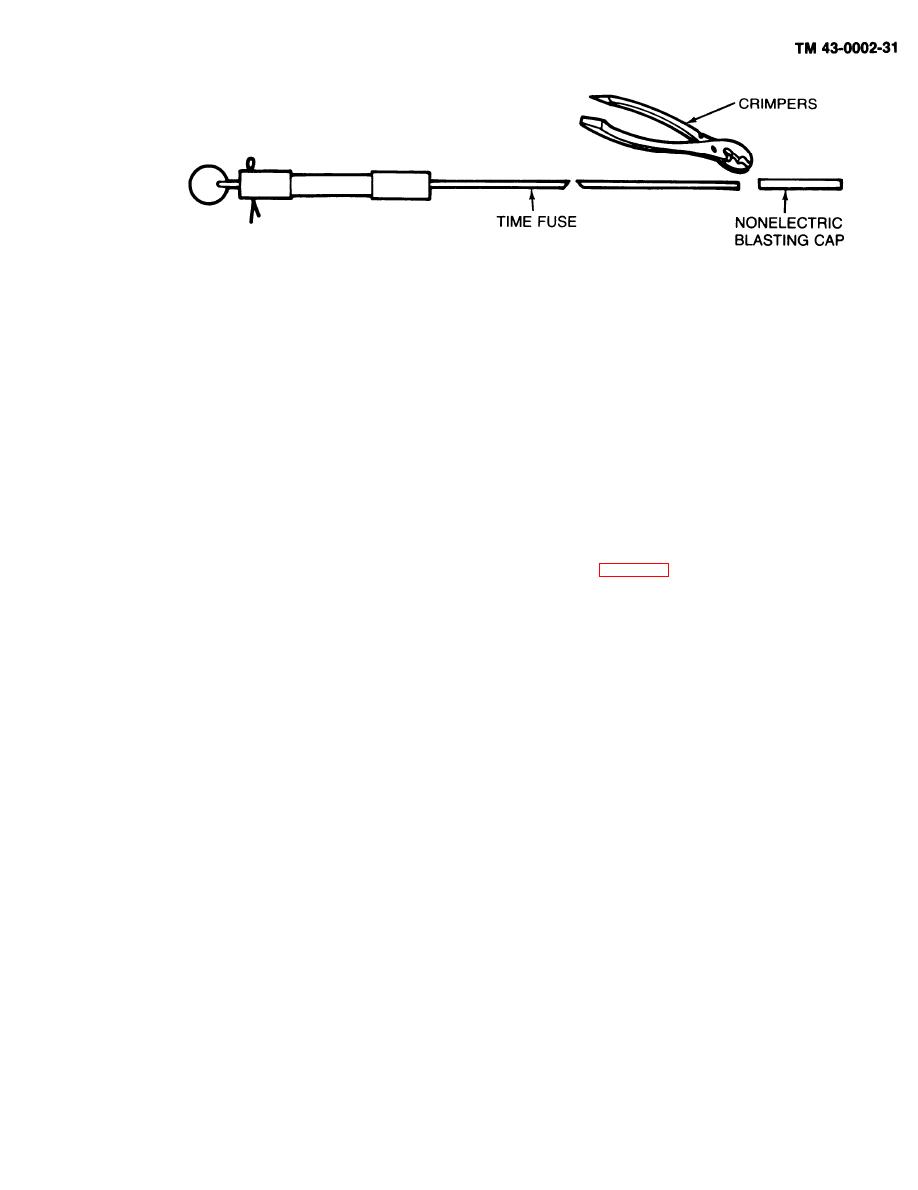 |
|||
|
|
|||
|
Page Title:
Section IV. DESTRUCTION BY FIRE |
|
||
| ||||||||||
|
|
 Figure 2-2. Nonelectric Firing System for Demolition Materials.
e. Detonating Charges.
(3) If charge is primed with nonelectric blasting
(1) Clear all personnel from surface danger
cap and time blasting fuse, ignite with igniter or matches
zone before firing charges.
and take cover.
(2) If charge is primed with electric blasting cap,
f. Malfunctions Involving Explosives. Report as
take cover before connecting wire to electricity source
prescribed in AR 75-1 and TM 9-1375-213-12.
g. Defective or Unsatisfactory Nonexplosive
and firing charges.
Equipment. Report and turn in as prescribed in
TM 38-750 and TM 9-1375-213-12.
Section IV. DESTRUCTION BY FIRE
2-12. Fire.
wounds, or death. Observe all safety precautions and
warnings (para 2-14) for destruction by fire.
a. Destruction by fire uses flame and heat to burn or
damage equipment. This method uses combustible
2-13. Required Materials for Using Fire. Combus-
materials to start the fire and to aid in burning. At unit
tible materials such as brush, scrap wood, empty boxes,
level, destruction by fire (burning) is the least time-
rags, paper, oil, and propelling charges can be used for
consuming of any destruction method. However, the
building fires and burning equipment. Ammunition items
conditions under which equipment will be burned are
that have been specifically designed for starting fires
command decisions which are made according to the
and burning equipment should be used when available.
tactical situation.
a. Thickening Compound, Fuel: M4. M4 thick-
b. Flame with intense heat will burn most equip-
ening compound is used to convert gasoline into thick-
ment and supplies. Properly concentrating equipment to
ened flame fuel, an incendiary gel (FM 20-33 and
be burned will provide a hotter, more destructive fire.
TM 3-366). Thickened flame fuel can be added to com-
c. Heat alone may not always damage equipment.
bustible materials to produce hotter fires. It can also be
An explosion may prematurely put out a fire. Therefore,
projected from flamethrowers to ignite fires and burn
mechanical destruction should be completed before a
equipment from a distance. M4 thickening compound is
fire is lit.
issued in a 2 1/2-pound can (NSN/DODAC
d. Fires can be built to produce either more heat or
1365-00-926-4076-K91 7) or in a 25-pound pail
more smoke. Heat is desired for destruction; but smoke
(NSN/DODAC 1365-00-143-7139-K920).
may be useful for obscuring enemy observation.
b. Starter, Fire: NP3, M2. The M2 fire starter is
e. Destruction by fire can be hazardous. Fires can
used to start fires in bad weather. It is a small rectangu-
spread rapidly and become uncontrollable. Intense heat
lar cellulose nitrate device filled with NP3 incendiary
from fires can cause explosions that scatter fragments.
mix. Operating instructions are printed on two sides.
Burning equipment may produce dense, toxic smoke.
Pulling its scratcher wire ignites a matchhead mixture.
Nearby personnel exposed to intense heat, smoke, or
This ignites the NP3 incendiary mix which burns hotly for
fragments may suffer severe burns, lung damage,
about four minutes. The M2 fire starter is issued 500 per
box (NSN/DODAC 1370-00-219-8566-L621).
2-5
|
|
Privacy Statement - Press Release - Copyright Information. - Contact Us |